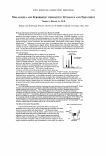]. Cosmet. Sci.J 57, 107-125 (March/April 2006) Availability and chemical composition of traditional eye cosmetics ("kohls") used in the United Arab Emirates of Dubai, Sharjah, Ajman, Umm AI-Quwain, Ras AI-Khaimah, and Fujairah ANDREW D. HARDY, Centre for Medical History, School of Humanities and Social Sciences, University of Exeter, Exeter EX4 4RJ, Devon, UK RICHARD I. WALTON and KATHRYN A. MYERS, Department of Chemistry, School of Biosciences, University of Exeter, Exeter EX4 4QD, Devon, UK and RAGIN! VAISHNAV, College of Medicine, Sultan Qaboos University, Box 35, Al-Khod 123, Sultanate of Oman. Accepted for publication December 16, 2005. Synopsis This study was undertaken in order to determine the availability and chemical composition of potentially lead-toxic traditional eye cosmetics ("kohls") in six of the seven emirates of the United Arab Emirates (UAE). Thus of especial interest was the percentage of the purchased samples that contained the toxic element lead. A total of 53 observably different kohl samples were found to be available overall in the six emirates: Dubai, Sharjah, Ajman, Umm Al-Quwain, Ras Al-Khaimah, and Fujairah. It was found that 19 of these samples had been previously analyzed by us in studies covering Oman, Abu Dhabi (city), and Egypt (Cairo). The techniques of X-ray powder diffraction (XRPD) and scanning electron microscopy (SEM) were used to analyze the remaining 34 samples. Overall, for the 53 kohl samples, it was found that 20 (38%) contained a lead compound (galena, PbS) as the main component. The other main components were found to be one of the following: amorphous carbon, calcite/aragonite (CaCO,,), goethite (FeO(OH)), hematite (Fe2O3 ), sassolite (H 3 BO 3 ), talc (Mg 3 Si4O10(OH)2 ), or zincite (ZnO). INTRODUCTION As part of our continuing study of Middle Eastern traditional eye cosmetics ("kohls") we have now looked at the availability and chemical composition of such cosmetics in six of the seven emirates of the United Arab Emirates (UAE), with especial reference to determining those containing a lead compound. We have already published a study on the kohls of Abu Dhabi city (1). Thus the six remaining emirates of Dubai, Sharjah, Ajman, Umm Al-Quwain, Ras Al-Khaimah (RAK), and Fujairah are covered here. For useful background information on eye cosmetics in general, and on Middle Eastern kohls 107
108 JOURNAL OF COSMETIC SCIENCE in particular, the reader is referred to our previous publications (1-3) and references therein. The older generation of Emirati men and women still use this traditional eye cosmetic for a variety of reasons: eye beautification, tradition, protection against the "evil eye," and as an ethnic medical remedy for eye strain/pain/soreness. In general, it is used more in the villages than in the urban areas of the DAE, and in the former it is still used on (very) young children as a perceived protection from the "evil eye"/the "evil one." Also, Bedu men wear it as a protection against the fierce desert sun. However, most of the middle-aged and younger generations of urban-living Emirati females now use the readily available modern eye pencils. Amongst the expatriates of the DAE, kohl is still used by (predominantly middle-aged) Indian ladies and also by Pakistani and Afghani middle-aged men. In our prior studies on the kohls of Oman, Abu Dhabi city, and Egypt (Cairo) (1-3), we found the toxic element lead (usually as the compound lead sulfide, PbS) to be present in some of the samples. The biohazards of lead are well known and were documented in the first century BCE by Vitruvius (4) and, as one example of several recent such studies, in a comprehensive study of its negative effects on the intellectual abilities of young children (5). Presented here, as part of our ongoing study into the presence of lead in Middle Eastern kohls, is a study of the availability and chemical composition of them in the emirates of Dubai, Sharjah, Ajman, Umm Al-Quwain, Ras Al-Khaimah (RAK), and Fujairah. MATERIALS AND METHODS MATERIALS The souks (local markets) of Dubai, Sharjah and Ajman were all visited several times and were very thoroughly investigated for the availability of traditional eye cosmetics (kohls). A later visit to the most remote (north) emirate of Ras Al-Khaimah (RAK), via the smallest emirate of Umm Al-Quwain, was sufficient to allow a reasonably thorough investigation of the main souk of RAK. However, the short time spent in Umm Al-Quwain was only sufficient for a limited investigation in its main shopping area. Unfortunately the final emirate, Fujairah, could not be visited by us and a "selection" of the available kohls in the Fujairah city souk was purchased by a colleague at a slightly later date. Initially all available kohl samples were purchased, but in our later souk visits only those kohl samples not seen before in this study were purchased, but with a careful record being made of the details of these "seen only" samples. The price per kohl sample, after bargaining, was usually between 1 and 5 dirhams (where 5 .6 dirhams was 1 GBP and where 3.5 dirhams was 1 US$), but occasionally the price was 10, 15, 20, or even 30 dirhams. For the six emirates investigated, the numbers of kohl samples purchased and "seen only" were: Dubai, 33 purchased and 1 more seen Sharjah, 23 purchased and 9 more seen Ajman, 7 purchased Umm Al-Quwain, 3 purchased and 4 more seen RAK, 9 purchased and 16 more seen Fujairah, 5 (a "selection") purchased. Thus, overall, 80 samples were purchased and a further 30 "seen only." Of these 80 purchased samples it was found that 5 3 were observably different the remaining 27 were identical to one of these 5 3 samples. Furthermore, on later com-
Purchased for the exclusive use of nofirst nolast (unknown) From: SCC Media Library & Resource Center (library.scconline.org)










































































































